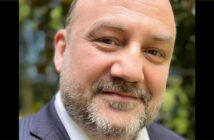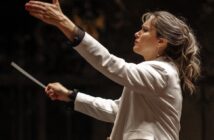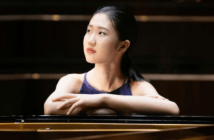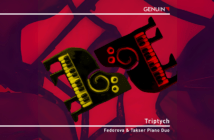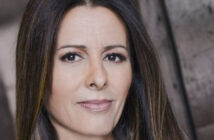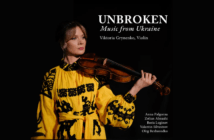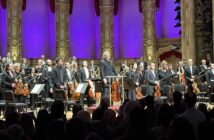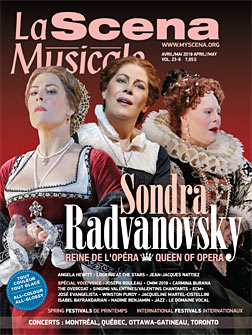
This page is also available in / Cette page est également disponible en:
![]() Francais (French)
Francais (French)
The first time I heard Sondra Radvanovsky was in 2010 in Montreal’s Salle Wilfrid Pelletier. She was a guest artist alongside the headliner of the concert, the late baritone Dmitri Hvorostovsky, one of my opera idols, whose performance fulfilled all my expectations. To say that she stole the show would be an understatement.
Frankly, I didn’t know much about this American soprano, who has since acquired Canadian citizenship. At first, I was in awe, but at the same time confused. Her voice seemed inconceivable: a large instrument that easily filled the hall and at the same time possessed a penetrating steel-like quality. I could visualize the sound of her voice spinning in circles around me, almost as if it was coming from many different directions. Whether at pianissimo or forte, her voice was clear as crystal. I looked unsuccessfully for the presence of microphones, speakers or anything that could enhance the sound, but what I was hearing was real!
Radvanovsky has now established herself as one of the leading sopranos of her generation, equally adept in Verdi and bel canto. Her performances in Bellini’s Norma at the Metropolitan Opera have been praised by critics and audiences alike.
Fast-forward to last October. I am standing with colleagues and friends after her flawless recital for the Club Musical de Québec in Quebec City’s Grand Théâtre de Québec. The audience holds what seems an eternal moment of silence, the breath of silence that comes after having experienced something extraordinary.
One of my neighbours breaks the silence with superlatives, but no words can measure up to the divine singing we have just heard. After a while, the silence returns and a bit of panic overcomes my awe when I remember that I have to interview the diva the following morning.
We met in a small loge at the Palais de Montcalm before Radvanovsky was to give a masterclass at the Conservatoire de Québec. I expected a superior and imposing diva. Her signature smile suggested rather a calm and humble demeanour. She offered us some tea and introduced us to her husband, Duncan Lear, who is also her manager.
Still very impressed by the previous evening’s performance, I cleared my throat nervously and began the interview. Ms. Radvanovsky, when are you coming to sing in Montreal?
“I would like to,” she answered emphatically. “The problem is my schedule is full until 2024. I’m going to be at the Canadian Opera Company (COC) every season now, Anna Bolena this year and then some Russian, some Czech and some new Italian.”
Although she wasn’t allowed to specify the roles, we can surmise through research that these engagements include Giordano’s Andrea Chenier, Dvořák’s Rusalka, Donizetti’s Poliuto, Verdi’s Un Ballo in Maschera and Macbeth.
Does she have plans to attack the Wagnerian repertoire? Strauss is growing on her, she replied, but singing this repertoire presents a language problem. “I don’t speak German and Wagner is so conversational. If you’re having a one-sided conversation, it’s not fun.”
Mastering language is important to Radvanovsky. While she speaks fluent Italian, she still works meticulously with her coach Tony Manoli to erase any hint of accent.
Three Tudor Queens

Sondra Radvanovsky in the title role of Donizetti’s Anna Bolena. Photo: Ken Howard/Metropolitan Opera.
In the 2015-16 Metropolitan Opera season, Radvanovsky completed the feat of singing the trilogy of the historical Tudor queens that Donizetti immortalized in his operas Maria Stuarda, Anna Bolena and Roberto Devereux.One of the first singers reported to complete this feat in the 1960s was Leyla Gencer, “La Diva Turca” (the Turkish diva). She was venerated by Italians and was considered the successor of Maria Callas, who was near the end of her illustrious career.
It is documented that Gencer’s voice was capable of dramatic power and possessed the flexibility and messa di voce to convincingly convey the three queens. Her success was recognized mostly in Europe. She sang 19 roles at La Scala but her popularity didn’t translate well overseas.
Later, soprano Beverly Sills completed this coup by singing the three queens in the 1974-75 New York City Opera season. She, unlike Gencer, had a light voice with easy coloratura, probably more in line with the expectations of what a bel canto singer should sound like.
Radvanovsky is more like Gencer. She has a very large and loud instrument that doesn’t particularly fit the mold of a “pretty voice” that some audiences and critics like to hear in bel canto. However, she deploys a wide variety of nuances throughout her range and adds great dramatic commitment to her characters.
She explains that the main difficulty of singing these three roles in one season is the stamina. “You have to complete 24 performances of three operas in a five-month period. These operas are in many ways written for completely different voices and temperaments.
“For example, Anna Bolena sits quite low in the vocal register, so my coach and I tried to add some ornaments to bring the tessitura a little higher and make the big climatic moments in the higher parts of my voice.”
Maria Stuarda is the most lyric role of the trilogy and also the shortest. “It’s more about the roles of Elizabeth I and Leicester.” She also argued that Roberto Devereux is the most demanding of the three operas.
“Historically, Elizabeth I had the most information written about her, so I had to really do my homework when preparing to portray her character. She is a woman on the edge and also at the end of her life, fighting to keep some semblance of control over her affairs.
“At the end of the opera, you see her physically and mentally fall apart. And vocally, it is a dramatic coloratura role, full tilt! She is angry for most of the opera and it shows in her demanding, florid music. It is very hard to sustain anger at that level for over three hours.”
In April and May the stentorian soprano will be in Toronto to close the 2017-18 opera season at the COC. “The last act of Anna Bolena is probably my favourite scene of all three of the operas. I mean, who doesn’t want to play a queen going crazy?”
Bel canto
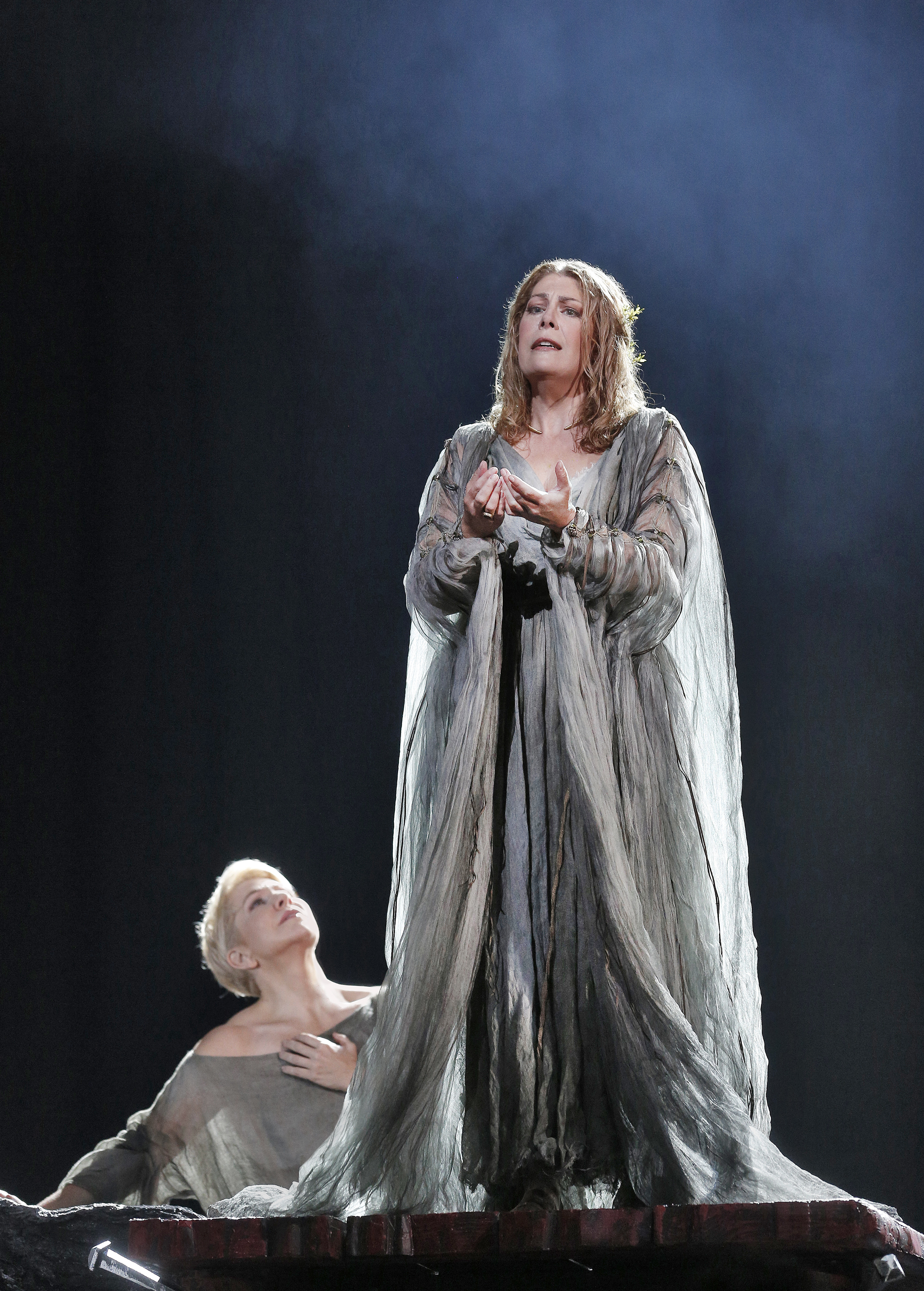
Joyce Didonato as Adalgisa and Sondra Radvanovsky in the title role of Bellini’s Norma. Photo: Ken Howard/Metropolitan Opera
During the past 10 years, it seems the term bel canto has been used extensively, becoming a sort of catchphrase among singing teachers and in singing circles. It has even been used to advertise lessons by a pop singer who promises to teach the “bel canto technique.”
Who better than Radvanovsky to demystify the essence of bel canto? She describes it as a stylized singing technique. “I call it voice pyrotechnics. You are required to do everything with the voice: high and soft, high and loud, low, crescendos, decrescendos.
“It’s kind of showing off vocally, but it really isn’t, because it is what the composers wanted. It’s also not necessarily about the orchestra or the production. Instead it truly focuses on the voice, as opposed to something like Puccini or Strauss, which is more a conversation between the orchestra and the singers.”
Radvanovsky points out that not all singers are required to master a bel canto approach. Tenors in the vein of Mario Del Monaco excelled in dramatic roles such as Otello and Andrea Chenier, but would probably be faced with more difficulties when approaching florid Rossini repertoire. On the other hand, certain dramatic, even Wagnerian singers, such as Radvanovsky’s contemporary Christine Goerke, have the ability to sing Brünnhilde and also emblematic bel canto roles such as Norma.
“I like a more dramatic voice singing bel canto,” Radvanovsky added. “I like a Norma that can shake you in your seat and you’re afraid of her, the same with Anna Bolena and Maria Stuarda.”
Live in HD

Sondra Radvanovsky as Elisabetta in Donizetti’s Roberto Devereux. Photo: Ken Howard/Metropolitan Opera
Radvanovsky is one of those singers that bridge two eras: the one “before cinematic opera” and the one after. Her popularity began rising about 10 years ago when Met cinema programming was hitting its stride. In her first Live in HD performance, in Il Trovatore in 2011, she was too aware of the cameras and had to learn to relax and forget about them. In her following HD performances, she concentrated on the audience in the opera house.
Radvanovsky has also had to come to terms with the fact that opera singers can sometimes make funny faces when they sing. The learning curve is evident. Notably in her acclaimed Norma, Radvanovsky managed to transmit some of the magic that happens when we hear her live. Her acting was subtle and her voice flawless.
However, as challenging as her first experiences were, she sees Met Live in HD broadcasts in a positive light. “Not everyone can afford the time or money to go to the Met to experience a live opera. Bringing the opera to them in their closest theatres is a gift.
“Plus, I really feel that it has made opera more attainable for everyone by showing people what happens behind the scenes and by interviewing singers. This is what we need to continue doing – make opera approachable and modern.
“That said, there is no experience like hearing a voice live in a theatre. The sensation of having a voice hit you in the middle of your chest and not only hearing the sound but feeling it, that is unique!”
Radvanovsky also advocates more music education in primary schools where she often goes to sing. “The mom of a 7-year-old told me that their boy insisted on listening to opera during their daily commute. You have to give kids a chance to like opera.”
Words of wisdom
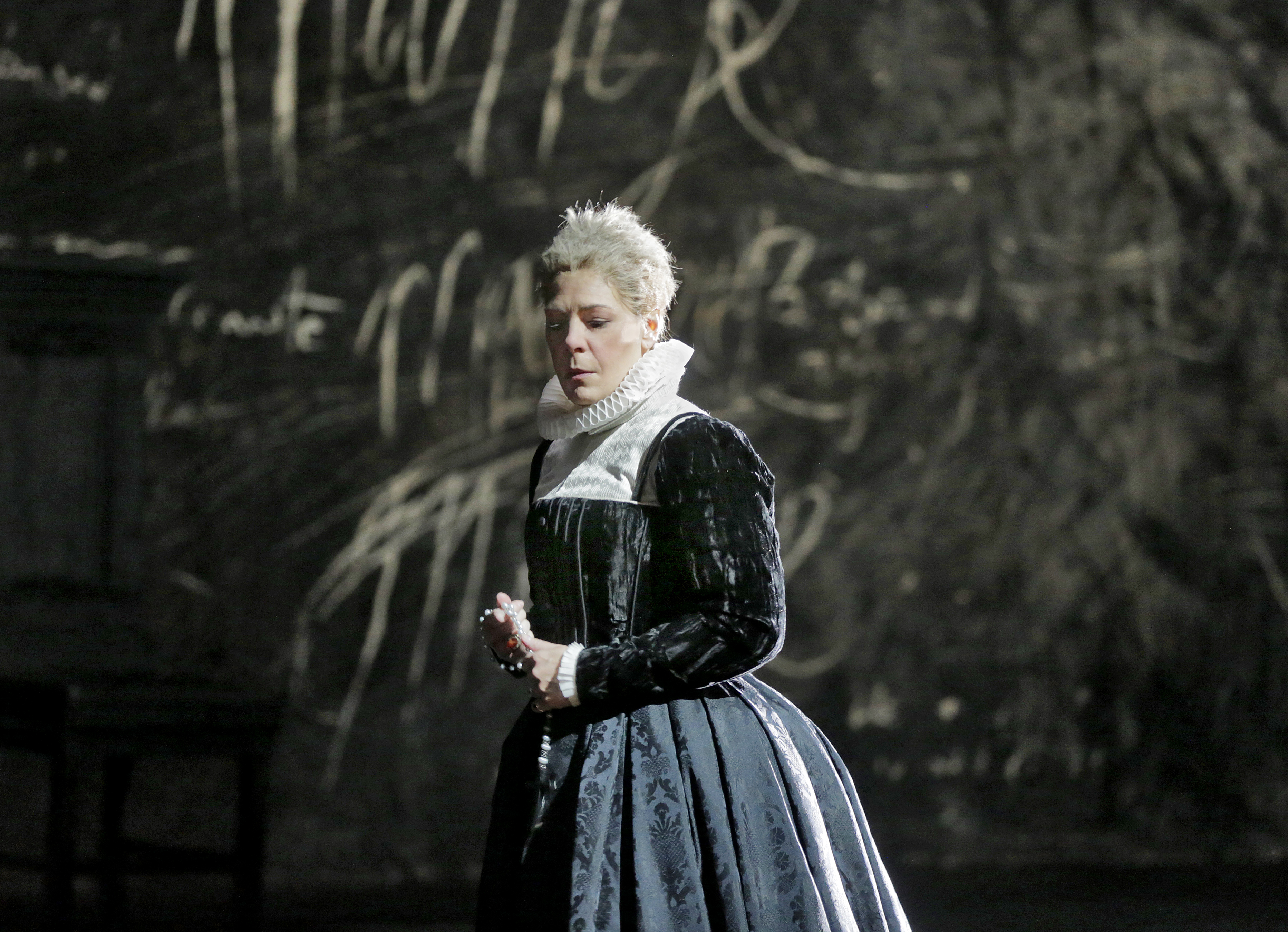
Sondra Radvanovsky in the title role of Donizetti’s Maria Stuarda. Photos: Ken Howard/Metropolitan Opera
Before and during the masterclass, Radvanovsky generously shares what she has learned over her 20-plus years of career. She wasn’t necessarily what we would call a naturally gifted singer. In fact, she was born with pneumonia. Doctors have speculated that one of her vocal cords was damaged by a tube introduced to help her breathe.
She grew up without knowing about this incident, but early in her career, she began having trouble and decided to have vocal surgery in 2003. Along with the operation, she also had to retrain her speaking voice, which was pitched too low.
“It’s funny, because as human beings we have a tendency to mimic our parents,” Radvanovsky observes. “My mom speaks very low and almost in a whisper. I also had to work with a speech therapist to get rid of my twang, which was impacting negatively. In my house we didn’t wash our clothes we “warshed” them. It was a very Midwestern accent.”
Now she tries to use the knowledge gained over the years to nurture and support young talent. I asked her to divulge the secret of her floating pianissimos. “Well, there really is no secret to singing piano. It takes time to really hone the skill and patience – patience to try again and again to push yourself to sing softer and softer.
“Yes, there is a true technique to achieving singing piano and that is always spinning the sound on the air, on the breath support, and always keeping the throat open. It is funny, but when I ask singers how they sing softly or ask them to show me how they sing softly, most of them close their throat off and pinch the air and then, in turn, the sound.
“Funny enough, you have to think contrary to what you would think is the approach to singing softly. You must speed up the column of air – I compare this to an old-fashioned top that spins – and constantly keep that air spinning.
“Also, the placement in the hard palate is very important for singing piano. If the position is too low in the palate, then the air can’t spin properly and then, many times, the tongue will get involved too, which it shouldn’t. Sounds easy, right? It has only taken me 20 years to figure it out!”
Her advice for aspiring young singers: “I won the [Metropolitan Opera] council auditions when I was 25. That said, not every 25-year-old [is ready for]the Met. I was young and naïve and said, ‘OK, yeah!’ Which in retrospective is crazy.
“Also, the times have changed so much. There are not so many opera houses, not many opportunities for young singers. That’s why some students stay in university longer and longer, because before we got the experience in small opera houses which are not there anymore.
“I think young singers nowadays have to work twice as hard, and not just vocally. You are expected to do more PR nowadays with social media and all that.
“I have seen so many singers, and other performers as well, not save properly for the future and end their careers penniless. When a singer signs a contract for an opera for, say, $1,000 a show, it looks like a lot of money. But then when you look at the breakdown of exactly how much of that money they will lose to taxes, agent fees, housing, travel and living expenses as well as voice lessons and coaching, you are looking at over 50% normally gone from each fee! So that amazing $1,000 fee quickly becomes less than $500.
“Another thing that singers may not know about a career is the travel. You will miss holidays, weddings, birthdays, etc. because you are on the road working. Not all of your friends will understand this. Being away from family is very difficult for some singers, especially if you have children.”
“As a young artist I had to learn pacing myself, and the greatest gift I learned from my former teacher was learning how to mark [singing half-voice during rehearsals]. She taught me how to find that small little head voice and I learn years later that singing high and soft comes out of that same marking position. That is something that really helps to save the voice, especially [when]singing all this bel canto. You can’t mark it down the octave because of the range, because Norma, for example, goes high to low to hi to ho!” Radvanovsky laughs.
The topic of Norma makes Radvanovsky quite philosophical. “I don’t want to be one of those singers that people are saying behind their back ‘when is she going retire?’ I want to leave when I’m on the top. For example, I just retired the role of Norma. I’m growing and moving on. I felt I’ve said everything that I could say with it and I don’t think that I can sing it any better. I’m almost 49 and singing is not as easy as when I was 41. It is mostly the stamina. Could I do it for 5 more years? Yeah. Do I want to? No way!”
Sondra Radvanovsky sings the title role in the Canadian Opera Company production of Donizetti’s Anna Bolena in Toronto from April 28 to May 26. www.coc.ca. www.sondraradvanovsky.com
This page is also available in / Cette page est également disponible en:
![]() Francais (French)
Francais (French)



